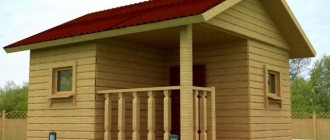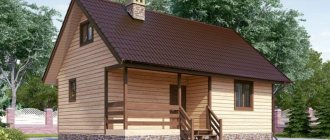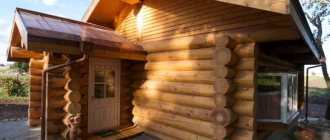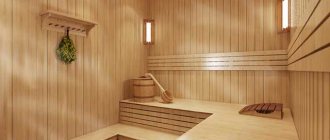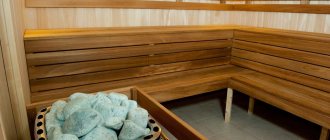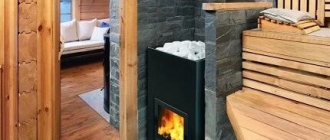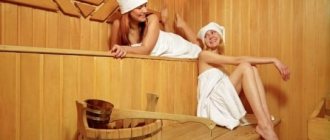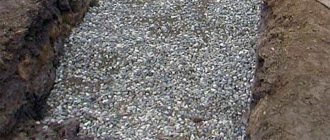Glued materials, such as timber or logs, allow you to create projects that are unique in their architecture. These can be not only residential wooden houses, but also buildings for completely different purposes, for example, exclusive hotels, administrative buildings for ski resorts, club houses for golf clubs.
Finnish baths and bath complexes are especially in demand. A Finnish bathhouse, just like a Finnish house, is a reliable structure that combines practicality, functionality, beauty and style. The Rovaniemi catalog presents the best designs of bath complexes, created taking into account high requirements for safety and comfort, based on many years of experience.
In our practice, quite often the client decides to simultaneously order a house and a bath complex made of laminated veneer lumber or logs. Typically, Finnish bathhouse projects are also developed by our architects, who have extensive experience and supervise both production and construction. As a rule, in this case, a common architectural concept and the same wall material are chosen for both buildings so that all objects on the site look like a single ensemble.
The harm and benefits of a sauna for the body
Bath procedures undoubtedly have a beneficial effect on the human body, and many experts recommend such procedures to maintain health and prolong youth. However, temperature changes are, in a sense, stress for the human body. And they can also cause harm.
How is it useful?
Positively affects the following human organs and systems:
- Skin - cleanses dirt and microorganisms, removes dead skin particles and promotes rejuvenation, helps get rid of acne and prevent their appearance, improves thermoregulation, helps smooth out wrinkles and makes the skin softer.
- Cardiovascular system – helps normalize work, improves blood circulation, stimulates the heart muscle.
- Nervous system - helps cope with stress, reduces tension, helps enrich the brain with oxygen, reduces excitability, normalizes sleep.
- Respiratory organs – promotes the removal of stagnant mucus, improves lung function.
- Musculoskeletal system - relaxes muscles and relieves fatigue, improves the elasticity of ligaments, improves nutrition and reduces swelling of the joints, promotes healing after injuries and accelerates the restoration of bone tissue.
Harm from visiting a sauna
Considering the large number of useful properties, we should not forget that this procedure is associated with overheating and temperature changes. And this, in certain cases, can negatively affect health. After all, constant and excessive overheating leads to problems such as dehydration, blood thickening, increased blood pressure, increased heart rate, weakness and even loss of consciousness.
In addition, it is necessary to take into account cases in which sauna procedures are generally contraindicated:
- for hypertension;
- for heart diseases;
- for chronic inflammation of the abdominal cavity;
- in the presence of various neoplasms and oncology;
- for some mental illnesses;
- in the postoperative period;
- with cholelithiasis with attacks;
- in the presence of infectious diseases;
- in the presence of purulent and bleeding wounds on the skin;
- with chronic hepatitis.
Women should refrain from visiting during pregnancy and lactation. And men need to observe moderation in the frequency and duration of thermal procedures, since their abuse can negatively affect the reproductive function of the body. Children are allowed to visit the sauna no earlier than three years of age after consultation with a pediatrician and only on the lower shelves.
- 6 months ago
#bath#sauna#sauna#key#sauna#key#bathhouse construction#sauna construction
- 6 months ago
- 6 months ago
#bath#sauna#sauna#key#sauna#key#bathhouse construction#sauna construction
- 6 months ago
#bath#sauna#sauna#key#sauna#key#bathhouse construction#sauna construction
- 6 months ago
#bath#sauna#sauna#key#sauna#key#bathhouse construction#sauna construction
- Enter the parameters of your sauna or simply leave a request
- We will receive an estimate for your project from each of our contractors
- We will choose the best offer and contact you
- You will get a sauna at the best price
Your promo code: “Sauna for you”! Tell it to our employee and the surveyor’s visit will be free for you.
What it is?
Historically, a Finnish sauna is a low, enclosed, small space from 2 to 6–8 square meters. m, designed for 2–3 people. Previously, such baths were heated by a hearth placed in the center of the room with hot stones. There was no chimney as such; ventilation was carried out through an open door and an inlet near the floor. The room was very dry and hot.
Instead of a washing room, there was a barrel with cold water or there was a natural pond nearby.
Modern technologies have made it possible to get rid of suffocating smoke and soot using ventilation systems and new modifications of stoves with chimneys. A barrel of water has been replaced by a font, pool or shower. The absence of windows is compensated for by electric lighting.
Prices
The final price of a Finnish sauna made of timber or logs is calculated individually and depends on the total area, material, region of delivery, and architecture. You can order a bath complex by contacting our sales offices in Moscow 8 (495) 660-18-66 or St. Petersburg 8 (812) 327-44-09 . If you are interested in luxury turnkey baths with construction in the regions of Russia, then you can call any of the indicated telephone numbers to get detailed advice or send us a request by filling out the form on the website.
Infrared sauna
Perhaps this is the most compact solution for a steam room, which can be installed even in a city apartment.
The body is heated here due to infrared radiation. Living in an apartment, such a sauna can be easily installed even on a loggia; all that remains is to install electricity.
One of the main advantages of an infrared sauna is its accessibility. The low temperature inside (45-55°C) and the absence of steam allow both older people and infants to safely enjoy spending time in it.
Another significant plus is saving time. You can warm up the infrared sauna within 15 minutes, without needing to heat the stove. The entire space inside the room is heated evenly. Moreover, you can assemble such a sauna in just 2 hours: you will need a screwdriver, a screwdriver and a minimum of skills.
Sauna on the island of Uunisaari - “Sauna Uunisaari”
The tiny beach island of Uunisaari, which can be reached by ferry from the Helsinki pier in just a couple of minutes, carries a feeling of nostalgia and is reminiscent of the past. Already in the 19th century, a famous bathhouse in Finland was located on the island.
The popular restaurant, barbecue areas and island beaches are open to the public all year round. But the outdoor Jacuzzi is exclusively for reserved use, except on Sundays, when you can purchase a public ticket and relax between steamy sessions on the harbor-view terrace with cocktails and live music.
A holiday at Uunisaari is an opportunity to relax in the warm water of a jacuzzi right outside
The island itself is located in the south of Helsinki and is a traditional holiday destination for many local residents. The isolated rocky landscapes in the south will make you feel like you are in the middle of the ocean. The restaurant windows offer breathtaking views of the Finnish archipelago.
On the northern part of the island there is a beautiful beach with changing rooms, showers and toilets. From the north terrace you have beautiful views of the city and harbor, and there is a restaurant and bar with great cocktails. Many people note that the Yuzhn restaurant prepares excellent fresh grilled dishes.
Rest room at Sauna Uunisaari
Traditional Finnish style with hints of classic Scandinavian design creates a feeling of peace and tranquility. Probably thanks to this detail, soaring in Uunisaari is so popular. The entire furnishings are thought out to the smallest detail, and the classic steam room with a powerful stove will not leave anyone indifferent. There are a total of 2 steam rooms in the complex, with separate changing rooms and private terraces.
“Uunisaari” sauna in Finland: photo of the steam room
The sauna is open daily from 14.00 to 21.00, but it is possible to extend the work. Day off is Monday. For a group order the following prices are set: for 10 people the cost of a 2-hour visit to the steam room is €350, for 15 people the same is €350, each additional 60 minutes costs €50. Ordering a jacuzzi is made together with a steam room and will cost you €150 for 2 hours.
Ideas for construction
Building your own sauna is the dream of most homeowners. A Finnish sauna with an electric stove allows you to equip it with your own hands in your apartment. There is a wide range of ready-made cabins for home saunas on sale. The size is designed for 1-2 users, takes up no more than two square meters of space and is placed in the bathroom or separately.
Such saunas are fully equipped with all necessary equipment and have detailed installation instructions. A specialist from the manufacturer will help you assemble the cabin and install all the components.
Construction of a sauna on a country site provides ample opportunities for creativity. It is quite possible to build a budget small bathhouse with your own hands. On an area of 10–12 sq. meters, everything you need fits in, the small size will allow you to save on heating, the small recreation room is expanded in the summer due to the veranda. The simplest design of a bathhouse with a veranda includes a steam room, shower and relaxation room or changing room and a terrace under a canopy.
It is worth spending extra money and increasing the size of the veranda. An open space under a canopy will allow you to admire the landscape and relax after hot procedures in the summer. Placing a barbecue area nearby will make for a comfortable evening relaxation in any weather. For year-round use of the bathhouse, panoramic glazing of the terrace is used, which is made of aluminum, wood or plastic sliding or swing structures. Glazing is also done with soft materials - polycarbonate or film.
Particularly noteworthy are permanent structures with a barbecue terrace under the same roof as a bathhouse. The brazier is installed in such a way that smoke does not enter the windows or the dining area. To do this, maintain a distance of at least two meters from the table and windows. The wall around the barbecue is finished with heat-resistant material - stone or bricks. For such a construction, you need free space on the site and significant financial investments.
Amateurs equip a dry sauna in a bath complex, where there is a comfortable shower, a swimming pool, a relaxation room, a billiard room or a room for training and spa treatments. These are elite complexes that use modern hydraulic structures under the roof or in the fresh air, which require communications and appropriate maintenance.
The main accent of such a bathhouse can be a glass roof, which will allow you to admire the starry sky while swimming in both summer and winter. The design of a bathhouse with a swimming pool in front of the terrace will combine a recreation area with an area of wellness treatments.
A budget-friendly and convenient option for summer cottage construction are barrel-shaped baths. This is an ideal option for a Finnish sauna. They are easy to install, have the necessary set of premises, quickly melt, are made of natural materials, and take up minimal space on the site.
Designing a Finnish sauna
Designs of baths and saunas can be very diverse. They are built as a separate building, installed in a house, country house or even in an apartment. Baths can be built-in or prefabricated, traditional or infrared. The interior design does not have any special differences, but even here you can do a lot to your taste.
Sauna projects
Performed taking into account wishes and financial capabilities. In modern life, not only rich people, but also not very wealthy people can build their own sauna. Since it is possible to develop and implement both expensive options for spacious saunas and more economical ones, for example, in the bathroom of an apartment.
Economy
A built-in mini-sauna takes up little space, however, even to implement such a project, the bathroom must be no less than the maximum permissible size. The ceiling height in it cannot be lower than 2 meters, and the area less than 3 square meters. In addition, it must have good ventilation and insulation. At the very beginning of construction, the room is thermally insulated with fiberglass with a thickness of 50 to 100 millimeters. The inside of the steam room is lined with wooden blocks. Exterior finishing can be done with ceramic tiles or plastic panels.
One-story house with sauna
Such projects are considered the optimal solution in the case when the area of the territory for construction does not allow “expanding on a grand scale.” At the same time, they provide for the construction of not only a bathhouse, but also a cottage with quite a sufficient number of rooms. The steam room is usually located next to the terrace or living room. As an option, you can choose a project for a Finnish house with a sauna.
Free selection of equipment for saunas and baths:
House with pool and sauna
The option of a sauna with a swimming pool located inside the house is considered more successful, but also more expensive. The owner of such a bathhouse will be able to cool off in a cool pool after a hot procedure at any time of the year without any problems. This layout requires a fairly large area of the room, but guarantees convenience for all family members.
We were getting ready to go to the bathhouse, but ended up in a sauna...
Once, my friend and I arrived at an invitation to “take a steam bath” with a company we knew, but to an unfamiliar “sauna” establishment. Then he said to me: “It turns out interesting, we were going to the bathhouse, but came to the sauna.” Some of those present smiled: “What difference does it make today? Bathhouse, sauna, everything is the same, the main thing is that there is good steam...” Well, yes, it seems the same at first glance, but what is the fundamental difference then?
The very concept of a sauna is not a steaming process, not a way to visit a bathhouse, but only a structure, a set of certain rooms. But the classic Russian bathhouse, also known as the gang bathhouse, is also identified by many with a set of premises. Therefore, further, without going into historical excursions, we will consider the important differences between the Russian bath and the modern Finnish sauna (namely, the “modern” type of “Finnish”, widespread throughout the world).
Features of the Russian classical bath
Without taking into account all the characteristics of the Russian steam bath, we will note only those that directly distinguish it from the Finnish sauna
- Humidity mode. The main difference between a Russian bath and a Finnish sauna is the relatively high air humidity. Standard humidity levels in a steam room are 60-70%. Because of this air humidity, it is believed that the characteristics of a Russian steam bath are closer to the conditions natural to the human body. Thus, it has a non-aggressive effect on the human body and, accordingly, is more physiological. Although this is a matter for debate.
- Temperature conditions. The temperature in the bath is maintained within 65-70°C. On the upper shelves the temperature can rise to 75-85°C. There is no doubt that you can raise the temperature to 100°C or even more, but only a few can withstand steaming with a broom under such conditions, and this can hardly be considered the norm for the majority.
- Features of vaping. What is a Russian bathhouse without a broom, birch or oak? When they start steaming and waving a broom in the bathhouse, it feels like the air is getting even hotter. This is where the healing effect of the bath begins. In a Russian bathhouse, a person moves, washes, steams, and turns up the heat as needed. In a Russian bath, due to maintaining the appropriate temperature and humidity, the steam is light and easy to breathe. Rest begins after the person leaves the steam room. Now you can say to each other: “Enjoy your steam,” go drink some fresh tea and cool down.
Features of a modern Finnish sauna
Two words about the classics. Classic wooden saunas are similar in functionality and internal design to classic rustic Russian baths and combine the features of a dry Roman and steam Russian bath. According to the classics, the temperature in the sauna is maintained within 70-100°C, and the humidity is from 10 to 30% and you can safely use a broom and add steam. But what do we have today?
- Humidity mode. In modern Finnish baths - saunas common outside of Suomi, air humidity is often from 5 to 15%.
- Temperature conditions. The low humidity mode makes it possible to increase the temperature threshold. Therefore, the temperature can reach 120-140°C. And for most people this temperature does not cause sharp rejection or unpleasant impressions.
- Features of vaping. The process of adopting procedures in the modern, widespread version of the Finnish sauna is determined and shaped by temperature and humidity conditions. The broom will not live long in such conditions. It will quickly dry out and crumble. And it’s simply impossible to steam with a broom in such conditions. In most cases today, electric stoves are used to heat a room, and excessive supply of steam by unknowing citizens leads to burnout of electric heaters. An attempt to supply water to the stones using a sprinkler increases the humidity, but does not give the desired effect, although it brings the temperature and humidity characteristics closer to the classics of the genre.
Pros and cons of Finnish stoves
A lot of the heat developed by a combustible material is lost from a poor design: a) A firebox that is disproportionate to either the amount of fuel or the heating surfaces of the stove. b) Smoke circulations, closed and inaccessible to room air. If there is not enough firewood in the firebox, as it should be in warm weather, then heat does not penetrate through the thick walls of the stove to its outer planes. A large amount of firewood placed above and on the sides of the combustion doors does not ignite at the same time and produces different products of different temperatures, some of which ignite earlier, others later, and some do not ignite at all. Under such combustion conditions, small particles of carbon, without combining with oxygen, are carried away from the firebox into the chimney, settling on its walls and smoke circulation in the form of soot and giving the smoke a thick and black color, proving a clear loss of combustible material. At the end of the fire, when the fire doors are left open to burn out the firebrands, room air flowing through the stove in large quantities cools the internal, just heated planes. The revolutions take little heat away from the smoke, this is proven by its high temperature in the view (from 182 to 267°C). Here, sometimes, sparks appear that ignite at a temperature of 300°, and this is almost half the temperature that occurs in the firebox. Another inconvenience is that Finnish stoves take up space in the room. This is not yet noticeable in two or three of them heated by a single stove, but in large houses requiring a significant number of stoves it is really difficult to accommodate them. On the other hand, such stoves provide the opportunity to supervise their firebox and channels.
Finnish sauna
Unlike the Russian one, the Finnish bathhouse has dry steam. Humidity is often no higher than 15%, but the air in such a steam room can reach 110°C. The walls of the Finnish sauna are also wooden. The main requirement is good thermal insulation, which minimizes heat loss. Unlike Russian baths, in Finnish baths they do not pour water on the stones. The steam room can be heated with or without a heater.
The classic Finnish sauna is smaller than the Russian one. Her project provides only two rooms - a steam room and a multifunctional room (dressing room, relaxation room combined with a shower). A ceiling with a height of 200-250 cm requires the installation of parallel shelves for sitting and lying.
Corner bath projects: features and advantages
The main distinguishing feature of corner baths is their non-standard shape. The classic version of building a bathhouse of this type involves the location of the steam room perpendicular to the rest rooms.
The main advantages of corner bath projects:
- The location of the sauna stove in the middle of the building allows you to heat all the rooms at once. In addition, with this arrangement of the furnace, heat loss is reduced. This is especially true in the winter season;
- corner baths were created primarily to save space on the site. As a rule, they are located in the corner of the site, so they do not violate the overall design picture;
- the corner design of the bathhouse can be used in problem areas, where, for example, with the help of such a building you can “bypass” a large tree or communications (electric poles, etc.);
- a building in the shape of a triangle or corner looks unusual and stylish;
- It is possible to make two entrances at once, which makes the operation of the bathhouse more convenient.
It is worth noting that, despite its size, even the most compact corner-type bathhouse will do its job perfectly - providing the owner or a group of friends with light steam and a pleasant rest.
Differences between a Finnish sauna and a Russian bath
The key differences between the two baths can be classified into several groups. More about them later.
Internal microclimate
The Finnish sauna is deservedly considered, firstly, the hottest, and secondly, the driest. The temperature here often rises to 90-100 degrees. Along with this, visitors, provided there are no individual contraindications, normally tolerate such extreme effects, primarily due to low humidity (no more than 20%).
Temperature readings in different baths
In a Russian steam room, the air at the highest points of the room does not heat up above 80 degrees, and the humidity is several times higher than the “Finnish” one and reaches 70% or more.
Experienced bath attendants know a simple postulate: the hotter the room, the drier it should be. To make it clearer, we give a simple example: if in a Finnish sauna heated to 100 degrees, the air humidity rises to 25-30% (only 5-10% above the maximum recommended value), the visitor will suffer burns to the skin and mucous membranes at best, a lung burn with a fatal outcome - under the most unfavorable circumstances.
The Finnish sauna is hot, but the humidity is very low
That is why there is no need to splash water on the stones in a Finnish sauna (except in extremely small quantities, if the air is too dry or you want to add a pleasant aroma to it with the help of herbal infusion, kvass, etc.) - you can miscalculate and provoke an increase in humidity to extreme values.
The Finnish sauna allows you to feel psychological relaxation, relieve physical fatigue, and cleanse your body without straining your muscles.
Arrangement of the heater
The second important difference between a Finnish sauna is the location of the stones in the stove - here they are laid out on the surface, while in a Russian bath the stones can be placed directly in the stove. For this reason, the heating and cooling of the Finnish sauna occurs faster compared to its Russian “sister”.
Heater in a Finnish sauna – photo
Finnish sauna. Bake
The design of the furnace unit itself is also different. In Russian steam rooms, in the vast majority of cases, solid fuel heaters are installed that burn wood. It is best to equip modern Finnish saunas with electric stoves. This issue will be discussed in more detail in subsequent sections.
Rules of soaring
Sauna in Finnish style. Let's understand the intricacies
The procedure for visiting the sauna also differs. If in a Russian bath it is customary, for example, to massage with a broom, then in a Finnish sauna they just sit, sweat and relax. There are no additional events provided. Maximum – scrub, honey mask, moisturizers, etc. Under no circumstances should you use a broom - at this temperature it will leave severe burns.
Face and body masks - the best effect in the sauna
After taking a shower (without using detergents) and entering the steam room, the visitor sits on a shelf and relaxes.
Photo inside a small Finnish sauna
The duration of the first approach should not be more than 3-5 minutes. Otherwise, you may overheat. If discomfort occurs before the specified time, leave the steam room.
Leave the steam room if you feel unwell
After leaving, take a cool shower or dip in the pool and head to the relaxation room. There you can drink fruit juice, weak tea or fresh kvass to restore fluid reserves lost with sweat.
After the steam room it’s nice to take a dip in the pool or pond
With further visits (no more than 3-6 in total), the duration of time spent in the steam room can be gradually increased. The permissible maximum is 10-15 minutes, regardless of training and experience. To increase the beneficial effect for the skin, you can do a honey massage.
Honey massage technique
The total duration of a trip to the bathhouse should be no more than 3 hours. It all ends with a shower. In this case, you can already use soap or shower gel to completely eliminate sweat. After washing, dry yourself and rest a bit. Once you have completely cooled down, go outside.
Taking a shower is a must
After visiting the bathhouse or sauna, you need to relax, or better yet, sleep
Design features
Russian bath
Architecture. Typically, this is a separate building built from coniferous logs. It has two required rooms: a steam room (soap room) and a dressing room (which often serves as a locker room, hallway and even a rest room between visits to the steam room). All rooms should be equipped with windows for better ventilation.
Bake. A wood-burning stove is heated in the dressing room. The main heat transfer element is heated stones (hence the name, “heater”). She settles down in the wall between the rooms. But the main part of the “heart of the steam room,” along with the stones, is located in the steam room.
You can select stoves with open and closed heaters. The first option is more practical when you steam several times a day. It quickly warms up the steam room, but under the influence of frequent watering, it quickly cools down. Stones in such a stove are placed above the firebox, heating them to 200 - 300 °.
The oven is closed for heat transfer (approximately at the level of the laid stones), has a steam door. When wood is burned, the door is closed and smoke does not enter the room. The temperature of the stones can reach 400 - 500°. Before visiting the steam room, the door is opened slightly, heating the room. Such a stove is heated well in advance (2-5 hours) before the start of the procedures. Due to the large accumulation of heat in the stones and masonry, a closed oven can cool down for up to 2 days.
The question of choosing a stove (open / closed) depends on a number of factors, including the size of the room, its strength, the availability of communications, and, of course, money.
Another difference between a sauna and a bathhouse is the design of their stoves. More specifically, in the arrangement of stones. In Russian, they are placed in a stove and therefore become hotter, but also cool down more slowly, and in a sauna, the stones lie on the surface of the stove.
Finnish sauna
Architecture. The room can be either free-standing or built-in. The interior decoration is the same as in Russian - bath grade wood. Unlike ours, it has three rooms: a steam room, a dressing room and a shower. The steam room itself is somewhat smaller than the Russian one, but the dressing room is larger. The architecture of the steam room is characterized by the absence of windows, but there must be forced ventilation.
Bake. Traditional, that is, wood-burning sauna stoves, are divided into two subtypes. Made from fire bricks or completely metal. The main elements are a heater and a chimney. Metal furnaces, in turn, are divided into two subtypes:
- With a built-in heater (in this case, heat transfer occurs from stones laid on top of the stove and metal screens* installed as a fence);
- With an iron chimney and fireplace (stones are laid in a horizontal chimney and, when heated, radiate heat).
*screens are used from stainless steel or low-carbon steel with a thickness of 3-5 mm.
The sauna stove with brickwork is structurally similar to the Russian one.
In recent decades, electric heaters have been used more often. They warm up quickly, can automatically maintain the set temperature and do not require forced removal of flue gases. They are divided into closed and open type devices (in which the spiral is placed on a ceramic base).
Stones for the stove: The mass of stones is calculated based on the volume of the steam room. On average 30 – 40 kg per 1 m3 of steam room.
Turkish bath
There is another type of bathhouse that is gaining popularity – the hammam. It is heated by warm air and water circulating in the wall and floor system. The boiler, located behind the wall, produces steam, which penetrates into the room through special holes.
The decor is all “oriental”. There is no wood, there are marble loungers and large washrooms. The temperature inside is no higher than 50°, but the humidity is under 100%. Swimming pools are a must. In general, it’s beautiful, rich, exotic... but for the soul of our person, it’s somehow unusual.
Materials
The heart of the Finnish sauna, and sometimes the only room, is the steam room. The finishing material must have good moisture resistance and a pleasant non-slip surface, not burn, not emit harmful substances when heated, and have aesthetic qualities. Natural wood meets all these requirements.
Cedar and larch are durable, resistant to moisture, produce a good healing effect, and also have high decorative cutting qualities.
The most expensive and valuable type of wood for finishing a sauna is African oak abash. It releases healing essential compounds and has a smooth, solid texture. Due to the high price, it is often used in fragments, for shelves and handrails. Slatted sauna cladding is the best option for a small room.
Much attention is paid to insulating the hot stove body from the wood. To do this, the stove and the wall around it are trimmed with natural, decorative stone or ceramic tiles
These materials have a high heat resistance coefficient and beautiful appearance. When choosing, you should not forget about the stones recommended for the sauna.
The shower and pool are finished with moisture-resistant materials: tiles, plastic panels or natural stone. The material must be hygienic and easy to clean in order to keep the room clean. In a limited area, instead of a pool, a bathing barrel is installed; in this case, the entire room can be made of wood.
The bathhouse building is erected from any building materials available in the region and corresponding to the budget. In terms of durability and performance, natural stone comes first. A stone structure looks brutal, will last for hundreds of years, is practically not exposed to atmospheric influences, and has low thermal conductivity.
The traditional building material – brick – has similar properties. Environmental safety is combined with excellent technical characteristics and aesthetic appearance. Brick allows the construction of complex architectural forms. A brick bathhouse is a symbol of solidity and quality.
The disadvantage of an unheated bathhouse is that it takes a long time for the room to warm up, but it also retains heat for a long time.
The classic material for construction and finishing of saunas is natural wood. Wood for a log house has the form of a log or timber. The log is more suitable for rural style, and the timber is easier to install. Both materials have the same decorative qualities.
The log house can be built from accessible and inexpensive pine. Pine has a beautiful color and knotty wood pattern. But due to high temperatures, resin begins to release and harden into unsightly streaks, so the steam room must be sheathed with a different type of wood. A pine recreation room will be an inexpensive and excellent basis for decorating with hunting trophies, carvings and paintings with hunting scenes.
These are inexpensive materials that are available for self-construction; the installation process does not take much time.
Recommendations for staying in the sauna
Before entering the sauna, you must take a warm shower without using detergents. If this is your first time, then your stay in the room should not exceed four minutes. More experienced people are recommended to stay for about seven minutes. Subsequent time of visits can be increased to fifteen minutes. It all depends on how you feel. It is also necessary to take a break between runs in the sauna. The best option would be around ten minutes. But it can be longer. But it is not recommended to wet your hair before the sauna. Otherwise, they will become brittle and dull from exposure to dry air and high temperatures.
Due to the fact that the skin is well steamed, you can make various masks, peelings or even wraps. The effect from them will be much more noticeable than after taking a bath.
